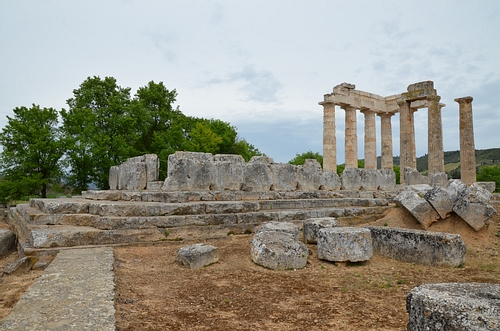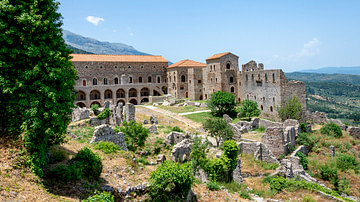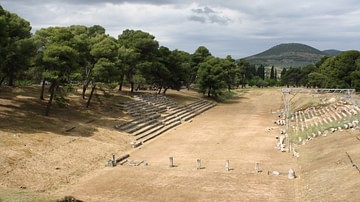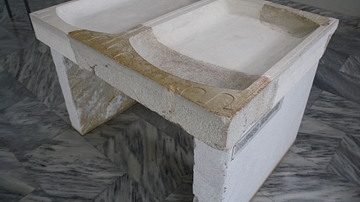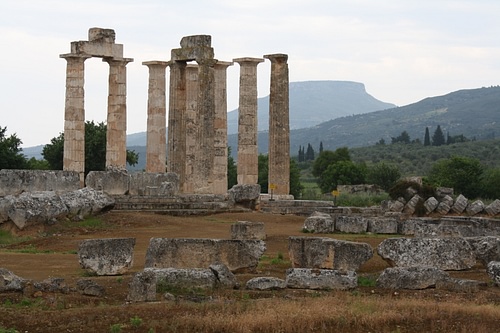
Nemea was a religious sanctuary in the northern Peloponnese of Greece where pan-Hellenic athletic games were held every two years from 573 BCE until 271 BCE, after which, the Games were definitively moved to Argos.
Early Settlement
Situated near the foothills of the Arcadian mountains, 333m above sea level in a long narrow valley, Nemea has cool summers and harsh winters, often with snow. The valley, south west of Corinth and around 10km north of Mycenae, is windy and drains poorly; in fact it was only through artificial drainage that the land was made arable. Indeed the name Nemea derives from the Greek word meaning to graze (υέμείυ). The area has been inhabited since Early Neolithic times (6000 to 5000 BCE) and was settled throughout the Bronze Age with architectural remains, in particular rock-cut tombs, dating from the mid-16th century BCE to the 12th century BCE, the time of the Mycenaean civilization. The site reached its period of greatest importance from the 6th to 3rd centuries BCE when for around a month every two years, athletes and spectators gathered for the pan-Hellenic Games, held under the control of nearby Kleonai and then Argos. The Nemean Games became a sporting event to rank alongside the other three major pan-Hellenic athletic games held at Olympia, Isthmia and Delphi. The Nemean Games were the youngest of the four but the fact that Nemea was held in as equally high regard as Olympia is evidenced in an Athenian law of c. 430 BCE which gave a victor at either event free meals for life.
Hercules & Nemea
The mythical origin of the Games is sometimes ascribed to Hercules who, after his first labour in which he had to kill the Nemean lion living in the caves of Mount Tritos above the site, established athletic games in honour of his father Zeus. A second and more likely mythological origin is the story of Opheltes. Lykourgos, the priest-king had a son Opheltes and seeking to protect his son Lykourgos asked the Delphic oracle for advice. The response of the oracle was to prevent the baby from touching the ground until he had learned to walk. Opheltes was put under the care of a slave called Hypsipyle but while engaged fetching water for some passing champions on their way to Thebes (the famous Seven against Thebes) the unattended baby was fatally attacked by a snake while he slept in a bed of wild celery. Taking this as a bad omen, the champions organised a funeral games to propitiate the gods and commemorate the unfortunate Opheltes. Thus the Nemean Games were born.
The Nemean Games
The events of the Nemean Games, held over several days and usually shortly after the summer solstice, were similar to those at the other sacred sites with the most important event being the stadion or foot-race over one length of the stadium track. Other events were foot-races over various stadium lengths: the diaulos (double), the hippios (four lengths), dolichos (as many as twenty four lengths) and the hoplitodromos (as the dialous but run in hoplite armour). In addition, there were competitions in boxing (pyx), wrestling (pale), combined boxing and wrestling (pankration) and the pentathlon - stadion race, wrestling, javelin (akonti), discus (diskos) and long jump (halma). Horse races were also held on the hippodrome track and included the four horse chariot race of 8,400m (tethrippon), the two horse chariot race of 5,600m (synoris) and the horse race of 4,200m (keles). Two further competitions were for heralds (kerykes) and trumpeters (salpinktai). The winner of the former won the right to announce the sporting events and victors and the latter won the privilege of announcing the herald. In the Hellenistic period competitions in singing, flute and lyre playing were added to the programme.
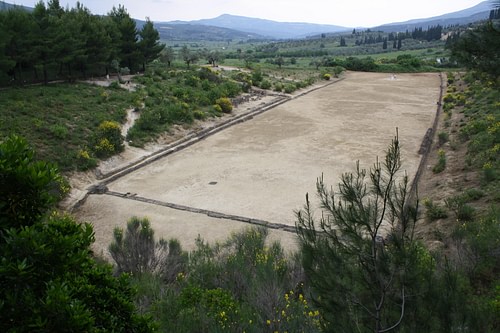
As with the spectators, athletes came from all over Greece and even beyond to compete and were separated into three age groups of boys (12-16 years), youths (16-20) and men (over 21). Athletes and competitions were supervised by specially trained Hellanodikai who acted as both referees and as judges and wore black, possibly in memory of the death of Opheltes. Athletes competed naked and victors were awarded a crown of wild celery.
Following the definitive movement of the Games to Argos, the site was largely abandoned and used merely for agricultural purposes. It was not until the 4th century CE that an early Christian settlement was established with the construction of a Basilica and baptistery - the foundations of which are still visible today. This settlement was itself abandoned in the mid 6th century CE when the valley's river dried up.
ArchitecturAL Remains
The ancient site has always been known; indeed three of the columns of the Temple of Zeus have never fallen down since they were originally erected. In 1884 CE French archaeologists made surface excavations following the drainage of the valley by French engineers the previous year. More comprehensive excavations were carried out between 1924-6 CE under the auspices of the American School of Classical Studies at Athens, once again in 1964 CE and then more systematically from 1973 CE by the University of California at Berkeley, which continues to the present day to excavate and manage the site and museum.
Architectural remains at the site are dominated by the impressive Temple of Zeus constructed c. 330 BCE. This was built on the site of an earlier temple from the 6th century BC which was destroyed by fire and from which blocks were used to construct the foundations of its replacement. The new temple was built of local limestone covered in fine marble-dust stucco with the inner sima in marble. The entrance to the temple was via a large ramp rather than steps - a common Hellenistic feature - and housed within was a large cult statue of Zeus, which has not survived. The temple was probably the last of the great Doric temples and measured approximately 22 x 42 m. The Doric exterior (peristyle) had 6 x 12 unusually slender columns, 10.33 m high. The Corinthian inner columns (6 x 4) also supported a secondary story of Ionic columns. There was no exterior sculpture or decoration. The wooden and terracotta tiled roof of the temple collapsed in the 2nd century CE and in the 5th century CE the majority of columns collapsed, not by earthquake but by the removal of blocks from the stylobate. Several columns have been re-erected in modern times using largely the original drums which still lie scattered around the site.
Running along the side of the temple was an unusually long (41 m) altar of which only the foundations survive. The altar was used for sacrifice and the pouring of libations during religious ceremonies. Also near the temple, there are a row of nine small rectangular buildings (oikoi) built in the early 5th century BCE and perhaps used as treasuries to house offerings from particular city-states or as meeting and banqueting rooms.
There are a series of buildings probably constructed as part of the same building programme in the 4th century BCE, almost certainly instigated by the Macedonians. These include a Bath house, the large Xenon building, a shrine to Opheltes and a triple stone reservoir.
The Bath house has a large central pool flanked by two tub rooms, each with four stone wash basins still in situ. This building was a forerunner of the later Greek palaistra-gymnasion complexes present at other sites such as Olympia and Delphi. The Xenon was a large rectangular building (85 x 20 m) with fourteen rooms and originally of two stories, of which, only the foundations remain today. The Xenon was most probably used as accommodation for athletes and trainers. The shrine to Opheltes was built on a small man-made mound and covered an area of 850 square metres enclosed by a low stone wall. Within were two altars, a cenotaph to commemorate Opheltes and at least some trees planted to form a sacred grove in one corner. The 4th century BCE shrine was a renovation of the earlier 6th century one and archaeological evidence demonstrates that the altars were used for animal sacrifice, the pouring of libations and the giving of votive offerings such as small statues and pottery. The triple reservoirs measure 3 x 9.8 m and reach a depth of 8 m; their exact function is not known.
Linked by a road to the sacred complex, the stadium of Nemea which is visible today, dates from 330-320 BCE and was built between two natural ridges providing an elevated vantage point for spectators and allowing a capacity as high as 30,000 people. A locker-room (apodyterion), once with an open central court, is connected to the stadium track by an arched tunnel measuring over 36 m in length and nearly 2.5 m in height. The track itself is the usual 600 ancient feet in length (178 m) with small marker posts indicating every 100ft. Still in situ is the stone starting line (balbis) where athletes placed their front foot.
Important archaeological finds at the site include a rare double-tray sacrificial table and a range of bronze sporting equipment including javelin tips, strigils and a discus. Other finds include votive statues, jumping stones and an impressive array of coins and pottery which attest to the wide geographical appeal of the Nemean Games. Since 1996 CE and held every four years, there have been a revival of the ancient Nemean Games with footraces held in the ancient stadium.
